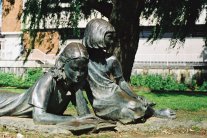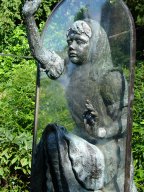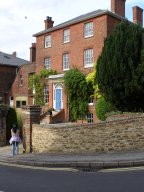Lewis Carroll
'Curiouser and curiouser!' cried Alice -- Lewis Carroll, Alice's
Adventures in Wonderland
I had sent my heroine straight down a rabbit-hole ... without the least idea what was to happen afterwards. -- Lewis Carroll
'When I use a word,' Humpty Dumpty said in a rather scornful
tone, 'it means just what I choose it to mean - neither more nor
less.' -- Lewis Carroll, Through the Looking-Glass
If - and the thing is wildly possible - the charge of writing
nonsense were ever brought against the author ... -- Lewis
Carroll, preface to The Hunting of the Snark
Lewis Carroll (1832-1898), was, in real life, the Oxford
Mathematics Lecturer (1855-81), the Rev Charles Lutwidge Dodgson,
or to his many young friends who knew him personally, Mr Dodgson.
Lewis Carroll is derived from the reversed and transmogrified
Christian names.
Lutwidge Ludovicus Lewis
Charles Carolus Carroll
Born the son of Charles Dodgson, Archdeacon of Richmond
Cathedral, Lewis Carroll was the third of eleven children. As a
child he took an early interest in mathematics. On being told
that logarithms was too difficult for a child to understand, his
response was 'Yes, but please explain.' As a child Lewis Carroll
produced the family magazine, where he showed his first interest
in parody, word-play and puzzles.
At Rugby, he was a diligent, but not very happy pupil. At Christ Church,
Oxford, he excelled in his preferred subject, mathematics.
Although ordained, Carroll never entered the church, though he
did occasionally preach. Ordination was at the time, a necessary
prerequisite to lecture at Oxford in mathematics. From entering
Oxford at the age of 18 in 1850, Carroll was to spend the next
fifty years of his life at Oxford until his death in 1898.
Lewis Carroll is best known as author of Alice's Adventures
in Wonderland and Through the Looking-Glass.
Though ostensibly children's books, they appeal to all ages.
 Alice's Adventures in Wonderland (1865) follows
Alice down a rabbit-hole in search of the White Rabbit who is
very late for a tea party. Alice meets a cast of strange
creatures including the Queen of Hearts, the Cheshire Cat, the
March Hare and the Mad Hatter. Written for Carroll's young
friend Alice Liddell (daughter of Henry
Liddell, Dean of Christ Church), it contains brilliant verbal
word play with logic pushed beyond the limit. One Christmas, the
BBC transmitted a brilliant radio dramatisation (possibly
available on audio cassette). The original manuscript was
presented to Alice as A Christmas Gift to a Dear Child in
Memory of a Summer Day.
Alice's Adventures in Wonderland (1865) follows
Alice down a rabbit-hole in search of the White Rabbit who is
very late for a tea party. Alice meets a cast of strange
creatures including the Queen of Hearts, the Cheshire Cat, the
March Hare and the Mad Hatter. Written for Carroll's young
friend Alice Liddell (daughter of Henry
Liddell, Dean of Christ Church), it contains brilliant verbal
word play with logic pushed beyond the limit. One Christmas, the
BBC transmitted a brilliant radio dramatisation (possibly
available on audio cassette). The original manuscript was
presented to Alice as A Christmas Gift to a Dear Child in
Memory of a Summer Day.
In the opening lines of Alice's Adventures in Wonderland, Alice peeks at the book her sister is reading. Not an interesting book she thinks as it has neither conversations nor pictures. Alice then gets her wish, a book with illustrations and interesting conversations.
Alice was beginning to get very tired of sitting by her sister on the
bank, and of having nothing to do: once or twice she had peeped into
the book her sister was reading, but it had no pictures or conversations
in it, and what is the use of a book, thought Alice, without pictures
or conversations?
 Through the Looking-Glass (1872) follows a similar
pattern, this time Alice walks through a looking-glass into a
strange looking-glass world. Alice finds herself as a white pawn
in a real-life chess game where all the pieces have come to life.
Whilst still brilliant, it never quite scales the heights of its
predecessor. Characters include Humpty Dumpty, Tweedledee and
Tweedledum. The book contains the nonsense verse of the
Jabberwock and the Walrus and the Carpenter.
Through the Looking-Glass (1872) follows a similar
pattern, this time Alice walks through a looking-glass into a
strange looking-glass world. Alice finds herself as a white pawn
in a real-life chess game where all the pieces have come to life.
Whilst still brilliant, it never quite scales the heights of its
predecessor. Characters include Humpty Dumpty, Tweedledee and
Tweedledum. The book contains the nonsense verse of the
Jabberwock and the Walrus and the Carpenter.
In Through the Looking-Glass, brooks and hedges divide the countryside into one giant chessboard, Alice plays the part of a pawn. Much as been made of the implausibility of the game by chess masters, and questioned why Lewis Carroll, as a passable chess player, did not construct a more plausible game.
... the chess framework is full of absurdities and impossibilities, and it is unfortunate that Dodgson did not display his usual dexterity by bringing the game, as a game, up to chess standard. He is known to have been a chess-player ... He might have searched for a printed problem to suit his story, or have made one. But he allows the White side to make nine consecutive moves(!): he allows Alice (a white pawn) and Alice becoming a Queen, to be two separate moves: he allows the White King to be checked without either side taking any notice of the fact: he allows two Queens to castle (!): he allows the White Queen to fly from the Red Knight, when she should take it. Hardly a move has a sane purpose, from the point of view of chess.
One can almost feel the indignation at the liberties taken. [S H Williams and Falconer Madan, The Lewis Carroll Handbook]
But this surely is to miss the point. We are in a surreal landscape, where nothing makes sense, other than in its own sense. On the same basis we should question the croquet game or the trial in Alice's Adventures in Wonderland.
Both books were illustrated by Sir John Tenniel, an earlier
version of Alice's Adventures in Wonderland was
illustrated by Lewis Carroll. Plans to put Tenniel's illustration
of the Jabberwock on the front cover had to be abandoned as it
was thought too frightening. For his model of Alice he chose
Mary Hilton Badcock, daughter of the Dean of Rippon. In
Through the Looking-Glass, published six years later,
she appears six years older.
As she grew older, Lewis Carroll and his young friend Alice drifted apart.
To enter the world of Alice is to enter a strange surreal world
where words take on different meanings and nothing is quite as it
seems. A rabbit that walks and talks, food and drink that has the effect of magical potions.
At times we have what could pass as Eastern mysticism: What happens to a flame when it goes out?
for it might end, you know, said Alice to herself, in my going out altogether, like a candle. I wonder what I should be like then? And she tried to fancy what the flame of a candle looks like after the candle is blown out, for she could not remember ever having seen such a thing.
Or as a Zen master would ask: What is the sound of one hand clapping?
Lewis Carroll wrote several other nonsense books, the best known
being The Hunting of the Snark (1876) - a nonsense
poem.
Under the name Charles Lutwidge Dodgson, Carroll published a
number of mathematical treatises, the best known being
Euclid and his Modern Rivals (1879).
Lewis Carroll's interest in cameras, photography and little
girls, would, in today's Puritanical hysteria, that sees child
molesters lurking behind every keyboard on the Internet, probably
be classed as child pornography. A collection of Lewis Carroll's
photographs is kept in Oxford securely behind lock and key -
strictly for the connoisseurs. This side of Lewis Carroll is
little known, and not discussed in polite society.
 Lewis Carroll spent the later years of his life living in
Guildford
with his sisters. The arrival of the railways to
Guildford meant that he could live in Guildford, but easily
travel to Oxford.
Lewis Carroll spent the later years of his life living in
Guildford
with his sisters. The arrival of the railways to
Guildford meant that he could live in Guildford, but easily
travel to Oxford.
Lewis Carroll died in Guildford (14 January 1898). He lies
buried in The Mount Cemetery, Guildford.
The plaque outside his Guildford home, The
Chestnuts, was designed by local children, who have
managed to incorporate many of his characters. An attempt was
made to steal the plaque in 2005 and it was removed for safekeeping.
To commemorate the 100th anniversary of the death of Lewis
Carroll (1998), a number of events were planned in
Guildford,
including an exhibition later in the year.
The Guildford Lewis Carroll Centenary Festival took place in
Guildford, 7-17 May 1998.
The Guildford Museum
contains a Lewis Carroll gallery.
One of the strengths of Lewis Carroll is that he can be
appreciated on several different levels, the weaver of children's
tales, the intertwining of nonsense and logic, then there is a third
level that few people see, the hidden, the cryptic,
that which has to be searched for. Many
of the verses were parodies of the prevailing verse for children
or mocked their regimented rote learning, something his young
audience would have understood and appreciated. On a much deeper
level still, the Alice tales can be read not as fun
at all but as a mournful loss of childhood and approaching old age. This can be
seen most sharply in You Are Old Father William,
a parody of Southey's The Old Man's Comforts, and How he Gained
Them, The Walrus and the Carpenter, a
sinister betrayal of children by adults as the young oysters are
lured away and then eaten, the postscript added to Alice's Adventures
in Wonderland, as seen through the eyes of her sister, and
the Epilogue to Through the Looking-Glass, a
mournful reminisce of a summer day, long, long gone.
It was on this deepest level that Jonathan Miller chose to focus
when he produced Alice's Adventures in Wonderland
for BBC television.
For the last hundred years we have thought of Alice as a
charming fairy story, full of cranky animals and jolly playing
cards, as brilliantly illustrated by Sir John Tenniel. But Alice
in Wonderland is a Victorian fantasy about the pains and perils
of growing up. I have discarded the traditional masks to reveal
an enduring melancholy.
The rapid changes in height Alice experiences, the mood changes, not being sure of her own mind, or who she was, could be seen as the changes experienced in puberty. And indeed, in later life, as Alice Liddell grew up and changed, she and Lewis Carroll drifted apart, and towards the end of her life, Alice Liddell resented being the Alice.
Sigmund Freud and his acolytes have had a field day with the symbolism in Alice, reading into it nonsense that is not there.
What then would Freud have made of the following entry on dreams in Lewis Carroll's diary (9 February 1856):
Query: when we are dreaming, and as often happens, have a dim consciousness of the fact and try to wake, do we not say and do things which in waking life would be insane? May we not then sometimes define insanity as an inability to distinguish which is the waking and which the sleeping life? We often dream without the least suspicion of unreality: 'Sleep hath its own world', and it is often as lifelike as the other.
It is into this surreal dreamworld we enter in Alice.
The writings of Lewis Carroll show that he had a great love of
little girls in general and Alice Liddell in particular. His
actions tell the same story, for it was not uncommon for him to
send a sick child in hospital one of his books in an attempt to
cheer them up. A lady who visited sick children in hospital,
asked that he write to a dying child, who had enjoyed reading
Alice, which he was happy to oblige.
It is a sad reflection of today's society that were he alive
today he would probably be hounded out of town by mob rule as a paedophile,
egged on by the gutter press.
The only modern writer to have come close to Lewis Carroll's use of
verbal word play and pushing logic beyond its limit has been Douglas
Adams (a small ape like descendant) with The Hitch Hiker's
Guide to the Galaxy (1979) - first broadcast as a BBC
radio series March 1978.
A recommended text on Lewis Carroll is The Complete
Illustrated Works of Lewis Carroll published by Chancellor
Press (1982). The Alice stories use the original Tenniel illustrations.
Recommended annotated texts:
Lewis Carroll, Alice in Wonderland, Wordsworth Classics, 1995 {not annotated, but has Lewis Carroll's original illustrations}
Lewis Carroll, Martin Gardner (ed), The Annotated Alice, Penguin Books, 1965, 1970
Lewis Carroll, Roger Lancelyn Green (ed), Alice's Adventures in Wonderland and Through the Looking Glass, Oxford Classics, 1982
Lewis Carroll, Hugh Haughton (ed), Alice's Adventures in Wonderland and Through the Looking Glass, Penguin Classics, 1998
On-line texts:
Audio dramatization:
For a contemporary account of Lewis Carroll:
Isa Bowman, The Story of Lewis Carroll, J H Dent & Co, 1899 {reprinted as Lewis Carroll as I Knew Him, Dover, 1972}
Morton N Cohen (ed), Lewis Carroll: Interviews and Recollections, MacMillan, 1989
Stuart Dodgson Collingwood (ed), The Life and Letters of Lewis Carrol, T Fisher Unwin, 1898
Stuart Dodgson Collingwood (ed), The Lewis Carroll Picture Book, T Fisher Unwin, 1899 {reprinted as The Unknown Lewis Carroll, Dover, 1961}
Synchronicity: I met my lovely Chinese friend Janna in Guildford. We discussed Lewis Carroll, and she not knowing he lived in Guildford, I took her to his house. A couple of days later we were due to meet at the Ambient Picnic. She called to say she could not make it as she was with friends. As she was calling me I was standing at a stall run by Dragon Books looking at a copy of The Annotated Alice which I thought she'd love to read. [The Annotated Alice edited by Martin Gardner]
Literature ~
Alice Liddell
Surrey-Hants ~
Guildford
(c)
Keith Parkins
1998-2005 -- September 2005 rev 5
 Alice's Adventures in Wonderland (1865) follows
Alice down a rabbit-hole in search of the White Rabbit who is
very late for a tea party. Alice meets a cast of strange
creatures including the Queen of Hearts, the Cheshire Cat, the
March Hare and the Mad Hatter. Written for Carroll's young
friend Alice Liddell (daughter of Henry
Liddell, Dean of Christ Church), it contains brilliant verbal
word play with logic pushed beyond the limit. One Christmas, the
BBC transmitted a brilliant radio dramatisation (possibly
available on audio cassette). The original manuscript was
presented to Alice as A Christmas Gift to a Dear Child in
Memory of a Summer Day.
Alice's Adventures in Wonderland (1865) follows
Alice down a rabbit-hole in search of the White Rabbit who is
very late for a tea party. Alice meets a cast of strange
creatures including the Queen of Hearts, the Cheshire Cat, the
March Hare and the Mad Hatter. Written for Carroll's young
friend Alice Liddell (daughter of Henry
Liddell, Dean of Christ Church), it contains brilliant verbal
word play with logic pushed beyond the limit. One Christmas, the
BBC transmitted a brilliant radio dramatisation (possibly
available on audio cassette). The original manuscript was
presented to Alice as A Christmas Gift to a Dear Child in
Memory of a Summer Day.

